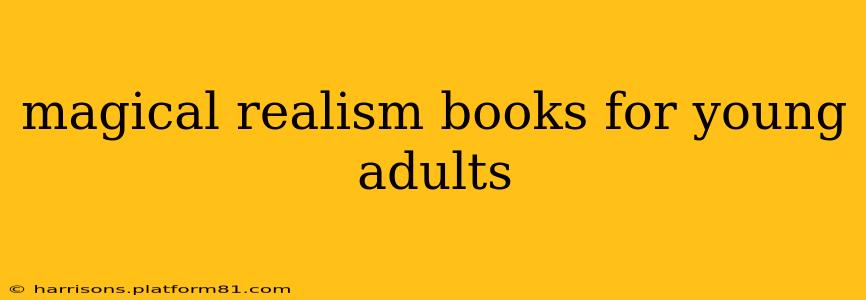Magical realism, a genre blending fantasy elements seamlessly into everyday life, offers young adult readers a captivating escape. It’s a genre that explores the extraordinary within the ordinary, prompting reflection on themes of identity, family, culture, and the power of belief. This list delves into some of the best magical realism books for young adults, perfect for sparking imagination and encouraging deeper engagement with the world around us.
What is Magical Realism in Young Adult Literature?
Before diving into specific titles, it’s helpful to understand what defines magical realism in young adult fiction. Unlike high fantasy, where magic is often the central driving force, magical realism subtly integrates fantastical elements into a realistic setting. These elements are often accepted as normal within the story's context, challenging readers to question the boundaries between reality and imagination. The best examples blend these elements seamlessly, creating a believable world where the magical adds depth and meaning to the characters' experiences.
Top Picks: Magical Realism Books for Young Adults
Here are some fantastic choices that perfectly capture the essence of magical realism for young adults:
"The House on Mango Street" by Sandra Cisneros:
While not strictly categorized as magical realism, this coming-of-age novel utilizes magical realism elements subtly. Esperanza Cordero's experiences growing up in Chicago's Latino community are imbued with a sense of wonder and magical thinking, reflecting the rich tapestry of her imagination and cultural heritage. The vibrant descriptions and Esperanza's poetic voice create a powerful and evocative reading experience.
"Like Water for Chocolate" by Laura Esquivel (adapted for YA):
Though originally written for adults, adapted versions of this novel exist and beautifully capture the essence of magical realism for a younger audience. The story follows Tita De La Garza, whose emotions are interwoven with her cooking, resulting in magical consequences. The novel explores themes of family, love, and tradition with a unique and enchanting flair.
"The Namesake" by Jhumpa Lahiri (adapted for YA):
This novel, also adapted for younger readers, tells the story of Gogol Ganguli, an Indian-American boy grappling with his identity and heritage. While not overtly magical, the novel incorporates subtle magical realism through the exploration of cultural traditions and the mystical aspects of Indian culture. The exploration of family history and identity makes it a compelling and thought-provoking read.
"The Alchemist" by Paulo Coelho (adapted for YA):**
Though not explicitly a YA novel, simplified versions of Coelho’s masterpiece cater to younger audiences. The journey of Santiago, a shepherd boy following his dreams, is peppered with encounters that blur the lines between reality and the mystical. The book’s central theme of pursuing one's Personal Legend is a powerful and inspirational message for young adults.
Frequently Asked Questions (FAQs)
Here are some questions young adult readers often ask about magical realism:
What are some other good magical realism books for young adults?
Many other excellent titles explore magical realism. Consider exploring the works of authors like Isabel Allende, Neil Gaiman (though he often veers into fantasy), and Carmen Maria Machado (for slightly older young adults). Searching for "magical realism YA" on Goodreads or other book recommendation sites can lead to a plethora of options.
How is magical realism different from fantasy?
The key difference lies in the integration of magical elements. In fantasy, magic is often a central plot device and the setting is explicitly fantastical. In magical realism, magic subtly enters a realistic setting, often treated as normal by the characters. The magical acts as a lens through which to explore realistic themes.
Where can I find more magical realism books?
Your local library is an excellent resource. Bookstores often have dedicated sections for young adult fiction, and you can browse by genre. Online retailers like Amazon and Goodreads offer extensive catalogs and reader reviews to aid your search.
Why is magical realism popular with young adults?
Magical realism appeals to young adults due to its blend of relatable characters and situations with fantastical elements. It provides a framework for exploring complex emotions and themes like identity, belonging, and cultural heritage in an imaginative and engaging way. The ambiguity inherent in the genre sparks critical thinking and allows for multiple interpretations.
By embracing the subtle magic within the realistic, magical realism books provide young adults with unique literary experiences that challenge their perceptions and inspire their imaginations. Happy reading!
